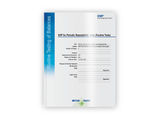To use all functions of this page, please activate cookies in your browser.
my.chemeurope.com
With an accout for my.chemeurope.com you can always see everything at a glance – and you can configure your own website and individual newsletter.
- My watch list
- My saved searches
- My saved topics
- My newsletter
Infrared thermometerInfrared thermometers measure temperature using blackbody radiation (generally infrared) emitted from objects. They are sometimes called laser thermometers if a laser is used to help aim the thermometer, or non-contact thermometers to describe the device’s ability to measure temperature from a distance. By knowing the amount of infrared energy emitted by the object and its emissivity, the object's temperature can be determined. Additional recommended knowledgeThe most basic design consists of a lens to focus the infrared energy on to a detector, which converts the energy to an electrical signal that can be displayed in units of temperature after being compensated for ambient temperature variation. This configuration facilitates temperature measurement from a distance without contact with the object to be measured. As such, the infrared thermometer is useful for measuring temperature under circumstances where thermocouples or other probe type sensors cannot be used or do not produce accurate data for a variety of reasons. Some typical circumstances are where the object to be measured is moving; where the object is surrounded by an electromagnetic field, as in induction heating; where the object is contained in a vacuum or other controlled atmosphere; or in applications where a fast response is required. Infrared thermometers can be used to serve a wide variety of temperature monitoring functions. A few examples provided to this article include:
There are many varieties of infrared temperature sensing devices available today, including configurations designed for flexible and portable handheld use, as well many designed for mounting in a fixed position to serve a dedicated purpose for long periods. Specifications of portable handheld sensors available to the home user will include ratings of temperature accuracy (usually plus or minus a degree or two) and other parameters. The distance-to-spot ratio (D:S) is the ratio of the distance to the object and the diameter of the temperature measurement area. For instance if the D:S ratio is 12:1, measurement of an object 12 inches away will average the temperature over a 1-inch diameter area. The sensor may have an adjustable emissivity setting, which can be set to measure the temperature of reflective (shiny) and non-reflective surfaces. A non-adjustable thermometer can be used to measure the temperature of a shiny surface by applying a non-shiny paint or tape to the surface. The most usual infrared thermometers are the:
Related equipment, although not strictly thermometers, are:
GallerySee also
|
| This article is licensed under the GNU Free Documentation License. It uses material from the Wikipedia article "Infrared_thermometer". A list of authors is available in Wikipedia. |






